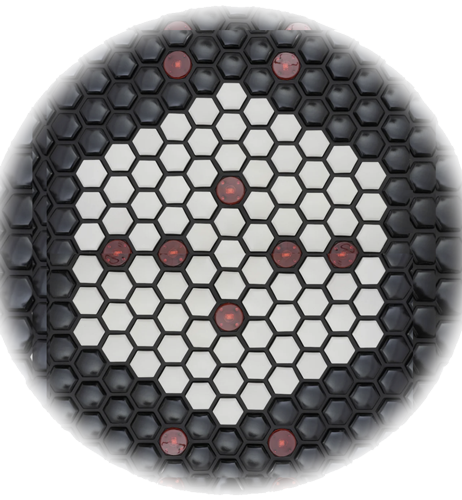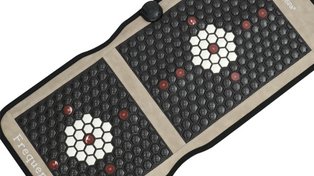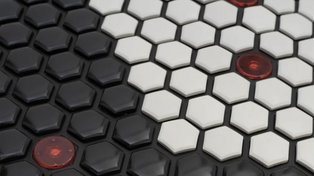Erlebe mit der MultiSpa Frequenzmatte ein ganzheitliches Wellness-Erlebnis in deinem Zuhause, und das zu jeder Zeit. Diese einzigartige Matte bietet dir nicht nur 50 verschiedene Frequenz-Programme, sondern auch 9 voreingestellte Magnetfeld-Therapieformen und 36 Infrarot & Biophotonen-Lichttherapiefelder.
Die pulsierenden Magnetfelder, die Tiefenwärme bis 70°C, die Schumann-Resonanz und die unverzichtbaren negativ Ionen sorgen für eine optimale Gesundheitsvorsorge zu Hause. Doch das ist noch nicht alles - die wärmespeichernden hexagonalen Edel-Mineralsteine lassen dich unvergleichlich tief entspannen und auftanken.
Jede Frequenzmatte wird in liebevoller Handarbeit hergestellt, um sicherzustellen, dass sie von höchster Qualität ist.
Hot Stone Therapie
Heilung durch heiße und erwärmte Steine findet sich in der Mythologie vieler vorangegangener Völker und Kulturen; so ist deren Einsatz im alten China schon auf 200 vor Christi datiert. Auch im pazifischen Raum vertrauten die Menschen auf die Wirkung des erwärmten Gesteins zur Linderung verschiedener Blessuren. Es wurden Verletzungen versorgt und Krankheiten behandelt.
Selbst zur Körperreinigung nahm man erwärmte Steine zur Hand. Das Wissen wurde in die Gegenwart übernommen auf unsere Zeit und unsere Bedürfnisse zugeschnitten und dient nun dazu, unser körperliches und seelisches Gleichgewicht zu festigen, Entspannung zu bringen und Blockaden zu lösen.
Wärmetherapie - Essenziell gegen Schmerzen und Krankheiten
Die Wärmetherapie ist eine Form der Physiotherapie, die zur Behandlung von Schmerzen und von nicht entzündlichen Erkrankungen eingesetzt wird.
Die Wärme wirkt entspannend auf die Muskulatur und fördert die Durchblutung und den Stoffwechsel im Körper. Dadurch können Schmerzen gelindert und der natürliche Heilungsprozess angeregt werden. Menschen erleben die Behandlung in der Regel als wohltuend und entspannend.
Infrarot Therapie - die heilende Kraft des Sonnenlicht
Infrarotlicht ist ein unsichtbarer Teil des Spektrums von Sonnenlicht. und macht zusammen mit sichtbarem Rotlicht etwa 50 % der Strahlungsenergie der Sonne aus. Durch seine speziellen Wellenlängen beeinflusst es das Leben auf unserem Planeten. Dieser Prozess ist unausweichlich wichtig für die Gesundheit und das Wachstum von Mensch, Tier und Pflanze.
Wenn Infrarotstrahlung auf Gewebe trifft, werden Moleküle in Schwingungen versetzt. Aufgrund von entstehender Wärme kommt es unausweichlich zu einem Temperaturanstieg. Infrarot-Strahlung kann die lokale Durchblutung fördern und gleichzeitig die Muskelspannung senken. Traditionell wird Infrarotstrahlung in der Medizin unter anderem zur Linderung bei Muskelschmerzen und Verspannungen eingesetzt, sowie bei Autoimmunerkrankungen oder Wundheilungsstörungen.
26 Studien beweisen spürbare Wirkungen von Infrarotlicht
- Tafur, J., & Mills, P. J. (2008). Low-intensity light therapy: exploring the role of redox mechanisms. Photomedicine and laser surgery, 26(4), 323–328. https://doi.org/10.21037/atm.2019.01.43
- Chung, H., Dai, T., Sharma, S.K. et al. The Nuts and Bolts of Low-level Laser (Light) Therapy. Ann Biomed Eng 40, 516–533 (2012). https://doi.org/10.1007/s10439-011-0454-7
- Hsu, W. L., & Yoshioka, T. (2015). Role of TRP channels in the induction of heat shock proteins (Hsps) by heating skin. Biophysics (Nagoya-shi, Japan), 11, 25–32. https://doi.org/10.2142/biophysics.11.25
- Hamblin M. R. (2017). Mechanisms and applications of the anti-inflammatory effects of photobiomodulation. AIMS biophysics, 4(3), 337–361. https://doi.org/10.3934/biophy.2017.3.337
- Matsushita, K., Masuda, A., & Tei, C. (2008). Efficacy of Waon therapy for fibromyalgia. Internal medicine (Tokyo, Japan), 47(16), 1473–1476. https://doi.org/10.2169/internalmedicine.47.1054
- Li, K., Zhang, Z., Liu, N. F., Feng, S. Q., Tong, Y., Zhang, J. F., Constantinides, J., Lazzeri, D., Grassetti, L., Nicoli, F., & Zhang, Y. X. (2017). Efficacy and safety of far infrared radiation in lymphedema treatment: clinical evaluation and laboratory analysis. Lasers in medical science, 32(3), 485–494. https://doi.org/10.1007/s10103-016-2135-0
- Maiello, M., Losiewicz, O. M., Bui, E., Spera, V., Hamblin, M. R., Marques, L., & Cassano, P. (2019). Transcranial Photobiomodulation with Near-Infrared Light for Generalized Anxiety Disorder: A Pilot Study. Photobiomodulation, photomedicine, and laser surgery, 37(10), 644–650. https://doi.org/10.1089/photob.2019.4677
- Podstawski, R., Borysławski, K., Clark, C., Choszcz, D., Finn, K. J., & Gronek, P. (2019). Correlations between Repeated Use of Dry Sauna for 4 x 10 Minutes, Physiological Parameters, Anthropometric Features, and Body Composition in Young Sedentary and Overweight Men: Health Implications. BioMed research international, 2019, 7535140. https://doi.org/10.1155/2019/7535140
- Beever R. (2009). Far-infrared saunas for treatment of cardiovascular risk factors: summary of published evidence. Canadian family physician Medecin de famille canadien, 55(7), 691–696.
- Hwang, S. G., Hong, J. K., Sharma, A., Pollack, G. H., & Bahng, G. (2018). Exclusion zone and heterogeneous water structure at ambient temperature. PloS one, 13(4), e0195057. https://doi.org/10.1371/journal.pone.0195057
- Laukkanen, T., Khan, H., Zaccardi, F., & Laukkanen, J. A. (2015). Association between sauna bathing and fatal cardiovascular and all-cause mortality events. JAMA internal medicine, 175(4), 542–548. https://doi.org/10.1001/jamainternmed.2014.8187
- Sears, M. E., Kerr, K. J., & Bray, R. I. (2012). Arsenic, cadmium, lead, and mercury in sweat: a systematic review. Journal of environmental and public health, 2012, 184745. https://doi.org/10.1155/2012/184745
- Avni, D., Levkovitz, S., Maltz, L., & Oron, U. (2005). Protection of skeletal muscles from ischemic injury: low-level laser therapy increases antioxidant activity. Photomedicine and laser surgery, 23(3), 273–277. https://doi.org/10.1089/pho.2005.23.273
- Selsby, J. T., Rother, S., Tsuda, S., Pracash, O., Quindry, J., & Dodd, S. L. (2007). Intermittent hyperthermia enhances skeletal muscle regrowth and attenuates oxidative damage following reloading. Journal of applied physiology (Bethesda, Md. : 1985), 102(4), 1702–1707. https://doi.org/10.1152/japplphysiol.00722.2006
- Morita, T., & Tokura, H. (1996). Effects of lights of different color temperature on the nocturnal changes in core temperature and melatoninin humans. Applied human science : journal of physiological anthropology, 15(5), 243–246. https://doi.org/10.2114/jpa.15.243
- Scoon, G. S., Hopkins, W. G., Mayhew, S., & Cotter, J. D. (2007). Effect of post-exercise sauna bathing on the endurance performance of competitive male runners. Journal of science and medicine in sport, 10(4), 259–262. https://doi.org/10.1016/j.jsams.2006.06.009
- Tadakuma T. (1993). Possible application of the laser in immunobiology. The Keio journal of medicine, 42(4), 180–182. https://doi.org/10.2302/kjm.42.180
- Bornstein, E., Hermans, W., Gridley, S., & Manni, J. (2009). Near-infrared photoinactivation of bacteria and fungi at physiologic temperatures. Photochemistry and photobiology, 85(6), 1364–1374. https://doi.org/10.1111/j.1751-1097.2009.00615.x
- Hiroshi Ohko, Yasunori Umemoto, Yuta Sakurai, Shouhei Araki, Daisuke Kojima, Yoshiichiro Kamijo, Kota Murai, Yoshinori Yasuoka & Fumihiro Tajima (2021) The effects of endurance exercise combined with high-temperature head-out water immersion on serum concentration of brain-derived neurotrophic factor in healthy young men, International Journal of Hyperthermia, 38:1, 1077-1085, DOI: 10.1080/02656736.2021.1922761
- Barolet, D., Christiaens, F., & Hamblin, M. R. (2016). Infrared and skin: Friend or foe. Journal of photochemistry and photobiology. B, Biology, 155, 78–85. https://doi.org/10.1016/j.jphotobiol.2015.12.014
- Alfredo, P. P., Bjordal, J. M., Dreyer, S. H., Meneses, S. R., Zaguetti, G., Ovanessian, V., Fukuda, T. Y., Junior, W. S., Lopes Martins, R. Á., Casarotto, R. A., & Marques, A. P. (2012). Efficacy of low level laser therapy associated with exercises in knee osteoarthritis: a randomized double-blind study. Clinical rehabilitation, 26(6), 523–533. doi.org/10.1177/0269215511425962
- Gale, G. D., Rothbart, P. J., & Li, Y. (2006). Infrared therapy for chronic low back pain: a randomized, controlled trial. Pain research & management, 11(3), 193–196. https://doi.org/10.1155/2006/876920
- Höfling, D. B., Chavantes, M. C., Juliano, A. G., Cerri, G. G., Knobel, M., Yoshimura, E. M., & Chammas, M. C. (2013). Low-level laser in the treatment of patients with hypothyroidism induced by chronic autoimmune thyroiditis: a randomized, placebo-controlled clinical trial. Lasers in medical science, 28(3), 743–753. https://doi.org/10.1007/s10103-012-1129-9
- Yeste, M., Codony, F., Estrada, E., Lleonart, M., Balasch, S., Peña, A., Bonet, S., & Rodríguez-Gil, J. E. (2016). Specific LED-based red light photo-stimulation procedures improve overall sperm function and reproductive performance of boar ejaculates. Scientific reports, 6, 22569. https://doi.org/10.1038/srep22569
- Wunsch, A., & Matuschka, K. (2014). A controlled trial to determine the efficacy of red and near-infrared light treatment in patient satisfaction, reduction of fine lines, wrinkles, skin roughness, and intradermal collagen density increase. Photomedicine and laser surgery, 32(2), 93–100. https://doi.org/10.1089/pho.2013.3616
- Vatansever, F., & Hamblin, M. R. (2012). Far infrared radiation (FIR): its biological effects and medical applications. Photonics & lasers in medicine, 4, 255–266. https://doi.org/10.1515/plm-2012-0034
Quellenangaben
- https://www.bfs.de/DE/themen/opt/anwendung-medizin-wellness/infrarot/infrarot.html#:~:text=Infrarot%2DStrahlung%20kann%20die%20lokale,bei%20Autoimmunerkrankungen%20oder%20bei%20Wundheilungsst%C3%B6rungen.
- https://schnelleinfachgesund.de/infrarotlicht/#Was_ist_Infrarotlicht
- https://vital-kosmetikakademie.de/blog/infrarotlicht-neue-erkenntnisse-uber-die-wirkung-auf-die-haut/
- Tafur, J., & Mills, P. J. (2008). Low-intensity light therapy: exploring the role of redox mechanisms. Photomedicine and laser surgery, 26(4), 323–328. doi.org/10.1089/pho.2007.2184





